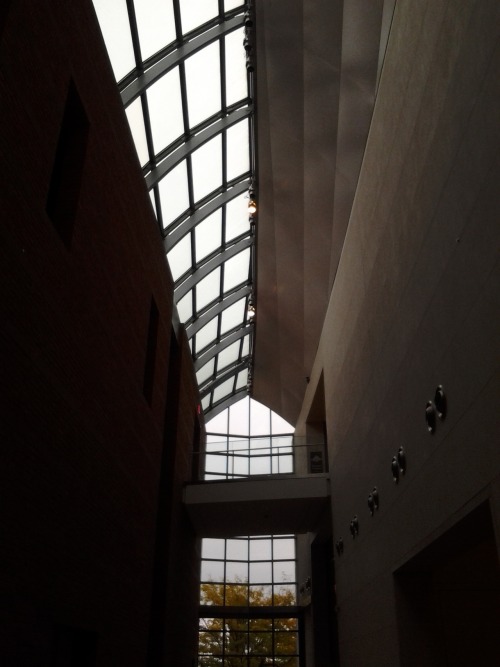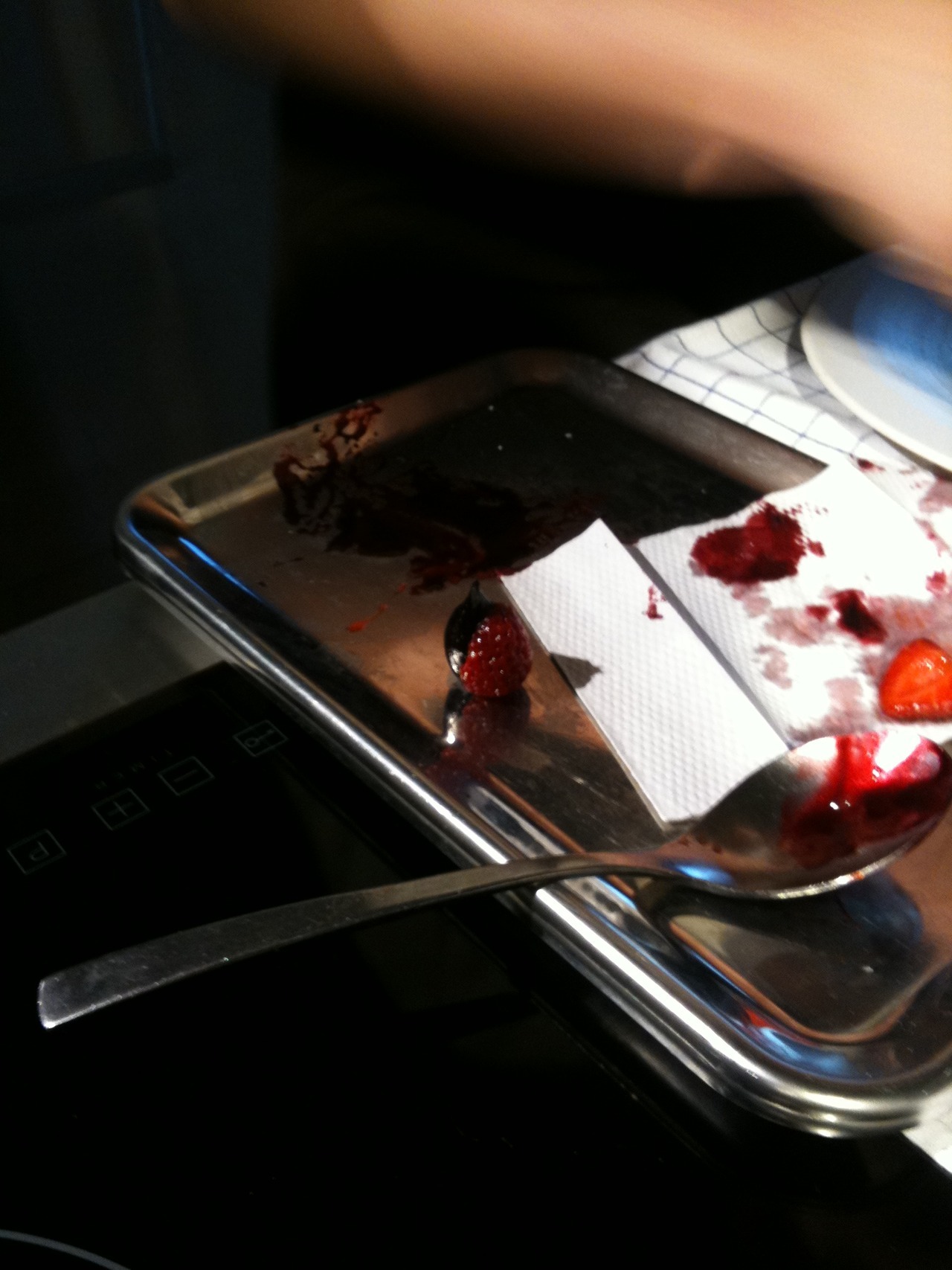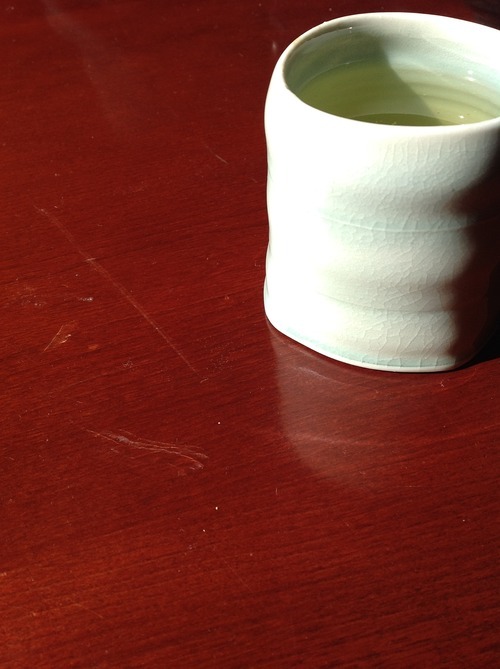
though the streets were overrun with orange, kettle korn, people in bad costumes, and fake cobwebs, jaho on the waterfront was empty and quiet. a kopi-c, a syphon, and a french press, and an hour and a half passed effortlessly. a&j king, earnestly artisanal bakers, was filled with the scent of butter and frangipane—but the locust-like swarms of halloween revelers had cleaned them out of all but a few classically formed brioches and cinnamon caramel cookies.
moshe safdie's addition to the peabody essex museum graciously balances light, air, mass, and gravity. it feels much like a small-scale version of the foster and partners great court in the british museum. there are many other wonderful things about the PEM. the main atrium contains a neat anish kapoor mirror sculpture (halo), though it would have been even more awesome suspended from the ceiling. the curatorial staff have taken the unusual approach of displaying artifacts from the historical collections with sly, smart interjections of modern and contemporary art and craft objects. why don't more museums with holdings in a range of periods do this? (louisiana in denmark is another noteworthy exception.) some pieces are tastily surprising: in the gallery of native american art, there is an avant-garde cape that appears to be fabricated from long strips of a translucent and silvery polymer, like something issey miyake would do. in fact, it is an unangax cape from the aleutian islands of alaska, made of pieces of sea lion intestine and dating to the early 19th century.
we took a short break at scratch kitchen, where the staff seemed overjoyed to be working on a drizzly and overrun sunday. 2pm is not too early for a beer when boulevard's tank 7 is on draft, and the pulled pork sandwich came on a firmly griddled bulkie roll which had not been made impenetrable by being toasted on the outside. i ate my half and then, when no one else was looking, the half that was not mine. the mac and cheese with bacon was made with orrechiette and the bacon, as advertised, made it "unspeakably delicious." the cauliflower soup had been passed through a tamis and was served with a drizzle of truffle oil—in this case a completely appropriate deployment. the owner once worked at harvest. a fine lunch in an unexpected spot.
back to the PEM, where the japanese galleries are particularly overstuffed with great stuff, including a monumental—yet modular—circular bench made of red oak with black lacquered hemp sections masquerading as gallery furniture. but where is the rest of e.s. morse's collection of japanese quotidian objects? let's hope that their massive planned expansion will return that collection to permanent display.
we had to leave when the museum closed for the day, but i did not want to.
Oct 29, 2012
salem
Posted by
vaughn tan
0
comments
![]()
![]()
Labels: art, craft, decisions, execution success, food, museums, neat, salem
Oct 25, 2012
nearly there

R&D in high-end cuisine looks a lot like R&D anywhere else, but some of its frustrations are domain-specific. up top, a dish that was nearly there but, as things turned out, not quite there enough.
read more here in the first of a series of vignettes on hydration is our highest priority illustrating life in some parts of the remarkably small world of research and development in food.
Posted by
vaughn tan
0
comments
![]()
![]()
Labels: art, complexity, craft, decisions, design, execution failure, food, instruction, moral fibre, research, science, sociology
Oct 23, 2012
going on progress
a 17-hour, 9.1 mile loop, with detours due to poor navigation. in order: everyman on west broadway, chambers street, some nyc city agencies, the west side linear park, the blue bottle on 15th, wework chelsea, the bowery kitchen supply store, blue bottle on 15th again, the high line, the architectural offices of diller scofidio + renfro, printed matter, moore brothers, booker and dax, and finally ippudo.
the high line is a gem in an already-great park city. i visited it a few days after it opened and remember being profoundly unimpressed by the sparse plantings but particularly liking the hardware fittings (look at those water fountains!). something made me come back whenever i was in the city and it was better every time.
the seating, plantings, and food/beverage choices are impeccable. a testament to the value of good taste combined with abundant cash and a benevolently autocratic decision-making process. there is a section just before the exit on 23rd st in which the footpath narrows slightly as it passes between two walls of abundantly leafed birches (a variety with strangely arrowhead-shaped leaves) trimmed just so their foliage pushes slightly into the path. the feeling of compression as you enter this passage of trees is a wonderful thing.
Posted by
vaughn tan
0
comments
![]()
![]()
Labels: art, biology, books, cities, coffee, complexity, design, execution success, furniture, high line, mornings, nyc, research, sociology, the good life
Oct 20, 2012
moral fibre
edge.org interviews daniel lieberman. of particular note:
... there's a reversal of class today. Now, it's only the very wealthy who can afford to be physically active and to eat a good diet, and it's the lower classes, the people in the working classes that cannot afford to actually be physically active. People who are well-off, the one-percenters or maybe the five-percenters of our country, can afford to go to health clubs and take yoga classes and buy organic food. But most Americans today, particularly those who are in the working class, have to work all day long, they have to commute long hours. They don't have time to exercise; they can't afford to buy food that's very healthy. The result is that there's now an interesting reversal that never occurred before in human evolution, which is that the wealthier you are, the healthier you are.and
We love comfort, and people make a lot of money selling us comfort, but I would challenge the notion that comfort is usually good for us.the meditations and the care of the self are two interesting books to think about here, as is the influence of weather on the development of moral fibre.
Posted by
vaughn tan
0
comments
![]()
![]()
Labels: complexity, design, dis-ease, education, enough, entropy, execution failure, execution success, fivefingers, moral fibre, sustainability, the good life, theory
Oct 19, 2012
low entropy life
what does a low entropy life look like? and is the only way to reduce entropy locally to export it into the enclosing system?
i hope this is more than just a rationalization of lifestyle choices.
Posted by
vaughn tan
0
comments
![]()
![]()
Labels: design, entropy, scalefree, sustainability, the good life, theory
Oct 18, 2012
for the time being
it's been a few years since i was up late in snowmass after a day at the woodshop reading annie dillard's for the time being, a many-threaded extended reflection on theodicy and the ways humans are evil to each other. the book ranges considerably into the realm of cultural evolutionary biology, which i've been thinking about of late (robert boyd and peter richerson write compelling about it in a book anyone interested in the evolution of culture should read). she writes:
Cultural evolution happens fast; it accelerates exponentially and, to put it less precisely, explodes. Biological evolution takes time, because it requires biological generations; the unit of reproduction is the mortal and replicating creature. Once the naked ape starts talking, however, "the unit of reproduction becomes" — in the words of anthropologist Gary Clevidence — "the mouth."more from pierre teilhard de chardin (who also plays a supporting role in dan simmons's hyperion cantos, one of my favourite space operas):
Geologists have considered every concentric layer forming the Earth except one: the layer of human thought. [chardin might also have said, and of human history and its impact on the land.] However far we look into the past, we see the waves of the multiple breaking into foam.a recurrent theme: the disparity between religion (which abrogates to itself the experience of holiness) and the experience of holiness itself.
Throughout my whole life, during ever minute of it, the world has been gradually lighting up and blazing before my eyes until it has come to surround me, entirely lit up from within. (chardin)freeman dyson's infinite in all directions (his gifford lectures) captures this same sense of holiness, of sensing the flame behind the form. there is also an element, as the shakers understood, of doing something for the sake of doing it. mother ann lee said "Do all your work as though you had a thousand years to live, and as though you were going to die to-morrow." dillard finds an example from one of the layers of our shared history:
The more I work, the more I see things differently, that is, everything gains in grandeur every day, becomes more and more unknown, more and more beautiful. The closer I come, the grander it is, the more remote it is. (giacometti)
Solutrean artisans knapped astonishing yellow blades in the shape of long, narrow pointed leaves. The longest Solutrean blade is fourteen inches long, four inches at its beam, and only one-quarter inch thick. Their intricate technique is overshot flaking; it is, according to Douglas Preston, "primarily an intellectual process" ... Hold one of these chert knives to the sky. It passes light. It shines dull, waxy gold — brown in the center, and yellow toward the edges as it clears. At each conchoidal fractured edge all the way around the double-ogive form, at each cove in the continental stone, the blade thins from translucency to transparency. You see your skin, and the sky. At its very edge the blade dissolves into the universe at large. It ends imperceptibly at an atom. Each of these delicate, absurd objects takes hundreds of separate blows to fashion. At each stroke and at each pressure flake, the brittle chert might — and, by the record, very often did — snap. The maker knew he was likely to lose many hours breath-holding work at a tap. The maker worked in extreme cold. He knew no one would ever use the virtuoso blades. He protected them, and his decendants saved them intact, for their perfection. To any human on earth, the sight of one of them means: someone thought of making, and made, this difficult, impossible, beautiful thing.looking beyond trappings and outward signs is the key. chardin is the originator of the virtual sacrament, first as a soldier in the second world war, and then later as an archaeologist in china:
Since once more, my Lord, not now in the forest of the Aisne but in the steppes of Asia, I have neither bread, nor wine, nor altar, I shall rise beyond symbols to the pure majesty of the real, and I shall offer you, I your priest, on the altar of the whole earth, the toil and sorrow of the world.it comes back to a particular type of love for the world:
We love in all we seek. The hidden shows up in too-plain sight. It lives captive on the face of the obvious — the people, events, and things of the day — to which we as sophisticated children have long since become oblivious. What a hideout: Holiness lies spread and borne over the surface of time and stuff like colour. What to do? There is only matter, Teilhard said; there is only spirit, the Kabbalists and Gnostics said. These are essentially identical views. Each impels and individual soul to undertake to divinize, transform, and complete the world, to — as these thinkers say quite as if there were both matter and spirit — "subject a little more matter to spirit," to "lift up the fallen and to free the imprisoned," to"work for the redemption of the world," to "extract spiritual power without letting any of it be lost," to "help the holy spiritual substance to accomplish itself in that section of creation in which we are living," to "mend the shattered unity of the divine worlds," to "force the gates of the spirit, and cry, 'Let me come by.'" When one of his Hasids complained of God's hiddenness, Rabbi Pinhas said, "It ceases to be a hiding if you know it is hiding." But it does not cease to hide, not ever, not under any circumstance, for anyone.on this, also see: a marvellous stage; wheatcakes; and the expanding self.
Posted by
vaughn tan
0
comments
![]()
![]()
Labels: books, complexity, decisions, epistemology, scalefree, sustainability
Oct 13, 2012
Oct 6, 2012
civilization
Pelorat said, "It seems to me, Golan, that the advance of civilization is nothing but an exercise in the limiting of privacy."
isaac asimov, foundation's edge
Posted by
vaughn tan
0
comments
![]()
![]()
Labels: books, complexity, decisions, design, epistemology, history, technology


